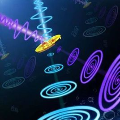Noisy Intermediate-Scale Quantum (NISQ) computers face a critical limitation in qubit numbers, hindering their progression towards large-scale and fault-tolerant quantum computing. A significant challenge impeding scaling is crosstalk, characterized by unwanted interactions among neighboring components on quantum chips, including qubits, resonators, and substrate. We motivate a general approach to systematically resolving multifaceted crosstalks in a limited substrate area. We propose Qplacer, a frequency-aware electrostatic-based placement framework tailored for superconducting quantum computers, to alleviate crosstalk by isolating these components in spatial and frequency domains alongside compact substrate design. Qplacer commences with a frequency assigner that ensures frequency domain isolation for qubits and resonators. It then incorporates a padding strategy and resonator partitioning for layout flexibility. Central to our approach is the conceptualization of quantum components as charged particles, enabling strategic spatial isolation through a 'frequency repulsive force' concept. Our results demonstrate that Qplacer carefully crafts the physical component layout in mitigating various crosstalk impacts while maintaining a compact substrate size. On various device topologies and NISQ benchmarks, Qplacer improves fidelity by an average of 36.7x and reduces spatial violations (susceptible to crosstalk) by an average of 12.76x, compared to classical placement engines. Regarding area optimization, compared to manual designs, Qplacer can reduce the required layout area by 2.14x on average
翻译:暂无翻译



